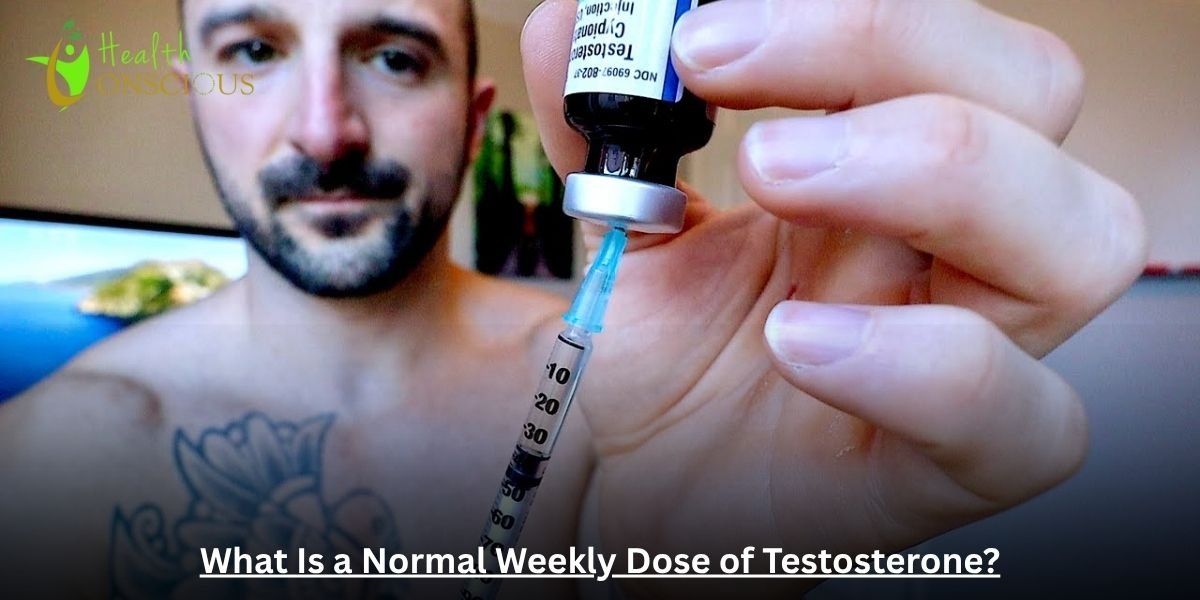Key Takeaways
- A normal weekly testosterone dose for men is typically 50-200 mg, but this varies significantly based on individual needs.
- The “1 ml” dosage is a measure of volume, not a consistent dose, and its effectiveness depends on the concentration of the testosterone solution.
- For women, testosterone dosages are much lower, usually ranging from 2-10 mg per week, and are used for specific hormone therapy needs.
- A safe dosage is one that maintains testosterone levels within a normal physiological range, requiring regular blood tests and medical supervision.
- High doses used for bodybuilding are not the same as therapeutic TRT and carry increased health risks.
Introduction
Testosterone replacement therapy (TRT) has become a popular topic for men and women seeking to address symptoms of low testosterone, from fatigue and low libido to muscle loss.
However, a common question arises: what is a normal weekly dose of testosterone? The answer isn’t a single number. A “normal” dose is highly individual and depends on several factors, including the patient’s age, the specific condition being treated, the type of testosterone used, and their body’s response.
The goal of TRT is to restore testosterone levels to a healthy range, not to achieve unnaturally high levels. This article will provide a comprehensive guide to understanding testosterone dosages for both men and women, covering everything from standard guidelines to safe usage and monitoring.
Normal Testosterone Dosage for Men
For men diagnosed with hypogonadism (low testosterone), the goal of TRT is to alleviate symptoms and return testosterone levels to a healthy physiological range. This is a medical treatment, and the dosage is carefully determined by a healthcare provider.
Standard TRT Dosage Range (50-200mg/week)
A standard starting dose for male TRT typically falls within the range of 50-200 mg per week. However, this is just a starting point. Doctors will often begin with a conservative dose and then adjust it based on regular blood work and how the patient’s symptoms respond to treatment.
The final maintenance dose is tailored to each individual to ensure they achieve a stable and healthy hormone balance without adverse side effects.
According to a study published in the Journal of Clinical Endocrinology & Metabolism, the goal is to maintain total testosterone levels within the mid-normal range (e.g., 450-600 ng/dL).
Testosterone Injection Dosage Chart
Here is a general guide to normal testosterone injection dosages for men using common esters.
| Testosterone Ester | Typical Dosage (mg/week) | Injection Frequency |
| Cypionate | 100-200 mg | Weekly or bi-weekly |
| Enanthate | 100-200 mg | Weekly or bi-weekly |
Note: These are general guidelines. Your doctor will determine your specific dosage.
Is 1 ml of Testosterone a Week Enough?
This is a common question, but it’s important to understand the difference between volume (mL) and dosage (mg). A “1 ml” dosage refers to the volume of liquid injected, not the amount of testosterone itself. Testosterone solutions come in different concentrations, most commonly 100 mg/ml or 200 mg/ml.
- If the concentration is 200 mg/ml, then a 1 ml injection delivers a dose of 200 mg.
- If the concentration is 100 mg/ml, then a 1 ml injection delivers a dose of 100 mg.
For most men on TRT, a dose of 100-200 mg per week is sufficient to normalize testosterone levels. Therefore, a 1 ml injection is often an appropriate and effective dose, depending on the concentration of the solution.
Is 2 ml of Testosterone a Week Enough to Build Muscle?
A weekly dosage of 2 ml of a 200 mg/ml solution delivers 400 mg of testosterone, which is often considered a supraphysiological dose—meaning it raises levels beyond the normal human range. While such a high dose can contribute to significant muscle mass and strength gains, it is not a standard therapeutic dosage for TRT.
Instead, it falls into the category of performance-enhancing use, often seen in bodybuilding. Such high dosages come with a significantly increased risk of side effects and are not recommended for long-term health.
Testosterone Dosage for Females
Testosterone therapy for women is used to address conditions like Hypoactive Sexual Desire Disorder (HSDD) or to manage symptoms after oophorectomy (removal of the ovaries). It’s important to note that the dosages for women are much lower than for men to avoid the risk of virilization (development of male characteristics).
How Much Testosterone Should a Woman Inject Per Week?
The recommended starting dose for women is minimal, typically around 2-4 mg of testosterone cypionate or enanthate injected subcutaneously every 1-2 weeks. This can be adjusted based on the woman’s response and regular blood tests to keep testosterone levels within a healthy female reference range. Most women on testosterone replacement therapy require between 2-10 mg per week.
Testosterone Dosage for Females (HRT Guidelines)
While a global consensus statement on testosterone therapy for women acknowledges its potential benefits for HSDD, it also highlights the lack of clear guidelines for other conditions. As a result, healthcare providers often rely on low-dose, off-label use of testosterone formulations approved for men.
The key is to start with a very low dose and carefully monitor for both therapeutic effects and potential side effects like acne, hair growth, or a deepening voice.
Safe Testosterone Dosage Guidelines
Adhering to safe testosterone dosage is critical to achieving therapeutic benefits while minimizing risks. The primary rule is that a safe dosage is always determined and monitored by a qualified healthcare professional.
Safe Testosterone Dosage Limits
A safe dosage is defined as one that keeps total testosterone levels in the blood within the normal physiological range for an individual’s age and sex. For adult males, this is typically between 300 to 1,000 ng/dL. Going beyond this range, especially for extended periods, can increase the risk of serious health complications, including cardiovascular issues, liver problems, and blood clots. Regular blood tests are the only way to ensure your dosage is safe and effective.
Testosterone Cypionate Side Effects
While testosterone cypionate is generally safe when used as prescribed, higher or unmonitored doses can lead to various side effects. These can range from mild and common to more severe.
- Common side effects: Acne, oily skin, hair loss, increased body hair, fluid retention, and mood swings.
- More serious side effects: Elevated red blood cell count (polycythemia), which can increase the risk of blood clots; gynecomastia (enlargement of breast tissue); sleep apnea; and liver toxicity.
- Long-term misuse can lead to shrunken testicles, infertility, and heart problems.
Testosterone Injection Methods
Testosterone injections are a popular method for TRT due to their effectiveness and predictable results. There are two primary injection methods, each with its technique and benefits.
Testosterone Injections Dosage (IM vs SubQ)
- Intramuscular (IM) Injections: This is the traditional method, where testosterone is injected deep into a muscle, typically the glute or thigh. IM injections are known to create higher peak levels of testosterone shortly after injection, followed by a more significant drop before the next dose.
- Subcutaneous (SubQ) Injections: This method involves injecting testosterone into the fatty tissue just beneath the skin, often in the stomach or thigh area. A study in The Journal of Clinical Endocrinology & Metabolism found that SubQ injections can provide more stable testosterone levels with fewer peaks and troughs compared to IM injections, potentially leading to fewer side effects and mood fluctuations.
Injection Frequency (Weekly vs Bi-weekly)
The frequency of injections depends on the specific testosterone ester and the patient’s preference.
- Weekly Injections: More frequent, lower-dose injections (e.g., 100 mg weekly) are often preferred as they maintain more stable hormone levels, reducing the “peak and trough” effect that can cause mood swings and energy fluctuations.
- Bi-weekly Injections: This involves a larger dose every two weeks (e.g., 200 mg every two weeks). While this means fewer injections, it can lead to more significant fluctuations in testosterone levels, with a high spike shortly after the injection and a sharp decline as the next dose approaches.
Monitoring Testosterone Therapy
Proper monitoring is essential for safe and effective testosterone therapy. It ensures that the dosage is correct and that the patient’s body is responding positively without developing serious side effects.
Essential Blood Tests for TRT
Before starting and during TRT, a doctor will order several blood tests to establish a baseline and monitor progress.
- Total and Free Testosterone: These are the most important tests to ensure the dose is achieving the desired therapeutic range.
- Complete Blood Count (CBC): To check for elevated red blood cell count (hematocrit), a common side effect of TRT.
- Lipid Panel: To monitor cholesterol levels, as TRT can sometimes affect them.
- Prostate-Specific Antigen (PSA): An important test for older men to monitor prostate health, as testosterone can potentially influence the prostate.
When to Adjust Your Dosage
Your dosage may need to be adjusted based on your blood test results and how you are feeling. If your testosterone levels are consistently too high or too low, or if you are experiencing side effects, your doctor will change your dose. They may also adjust the dose if your symptoms do not improve. The goal is to find the “sweet spot” where your symptoms are relieved and your blood work is within a healthy range.
Testosterone and Muscle Building
Many people, particularly those in the fitness community, are interested in the link between testosterone dosage and muscle growth. It’s crucial to differentiate between therapeutic TRT and the supraphysiological doses used for muscle building.
Is 1 ml of Testosterone Enough to Build Muscle?
As discussed earlier, “1 ml” is a volume, not a dose. Assuming a concentration of 200 mg/ml, a 1 ml injection (200 mg dose) is often the upper end of a therapeutic TRT dose. While this dosage will help restore muscle mass and strength in a hypogonadal man, it is not a “bodybuilding” dose. The muscle-building effects are a result of restoring normal hormone function, not a result of a massive anabolic stimulus.
TRT vs Bodybuilding Dosages
This is a critical distinction. TRT is a medical treatment for a diagnosed condition, with dosages designed to return hormone levels to a normal, healthy range. Bodybuilding dosages, on the other hand, are often several times higher than TRT doses, sometimes reaching 400 mg, 600 mg, or even more per week.
These high doses are used to create an unnatural anabolic environment for rapid muscle growth, but they also come with a much higher risk of severe side effects and long-term health consequences.
FAQs
What’s the Maximum Safe Testosterone Dose?
There is no single “maximum safe” dose. A safe dose keeps your blood testosterone levels within a normal physiological range (300-1,000 ng/dL). Anything above this level, especially for extended periods, is considered unsafe and carries significant health risks.
Can Women Use Male TRT Protocols?
No. Female testosterone needs are vastly different from men’s. Using a male TRT protocol would lead to supraphysiological testosterone levels in a woman, resulting in virilization and a high risk of serious health complications.
How Long Until TRT Shows Results?
Improvements can be gradual. Effects on mood and energy may be noticed within 3-6 weeks, while changes in body composition, such as increased muscle mass and decreased fat mass, may take 3-6 months.
Signs Your Testosterone Dose is Too High
Common signs of a dose that is too high include increased acne, irritability, mood swings, elevated blood pressure, and a high red blood cell count. If you experience these symptoms, you should contact your doctor immediately.
Difference Between TRT and Steroid Cycles
TRT is a medically supervised treatment for low testosterone to restore hormone levels to a normal range. A steroid cycle involves the non-medical, often illegal, use of high-dose testosterone to achieve supraphysiological levels for performance enhancement, carrying a much higher risk of side effects.
Final Thoughts
Determining a normal weekly dose of testosterone is a highly individualized process that must be overseen by a medical professional. The goal of TRT is not to achieve the highest possible hormone levels but to restore a healthy balance that alleviates symptoms and improves overall quality of life.
Whether you are a man or a woman, a safe and effective dosage depends on your unique needs, and it is always adjusted based on regular monitoring and blood tests. Never self-administer testosterone or use unprescribed doses, as the health risks far outweigh any potential benefits.



